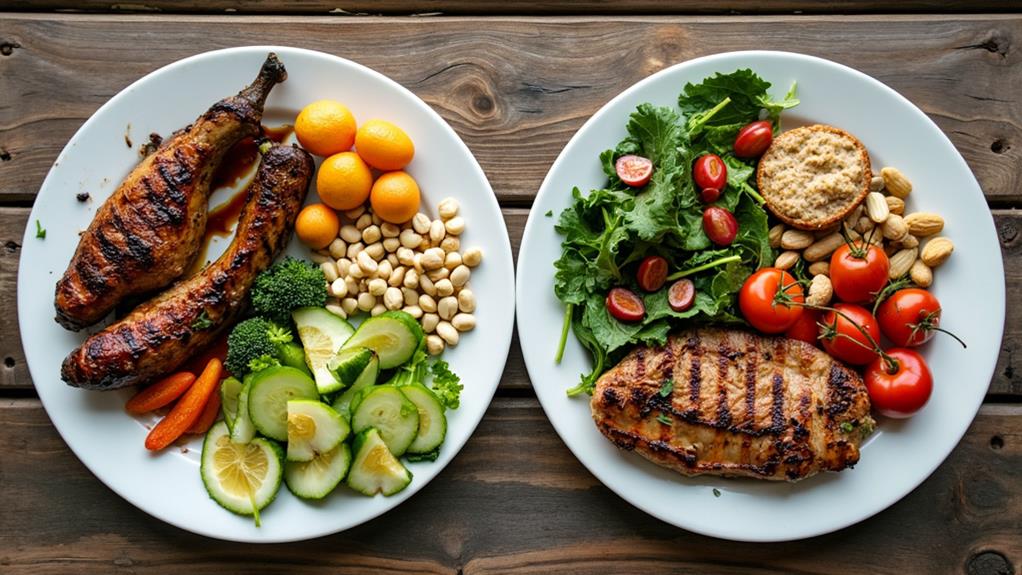When considering the Paleo and Whole30 diets, you might wonder how they differ despite their apparent similarities. Both approaches emphasize whole foods and eliminate processed items, but their goals and methods diverge substantially. For instance, Paleo encourages a long-term lifestyle change inspired by ancestral eating habits, while Whole30 is a short-term, 30-day reset with strict rules. If you're curious about how these differences affect food restrictions, allowed ingredients, and sustainability, you're about to uncover some surprising distinctions that could influence your dietary choices. When it comes to food restrictions, the Paleo diet focuses on eliminating grains, legumes, and dairy, while the Whole30 diet takes it a step further by also cutting out alcohol, added sugars, and certain preservatives. However, both diets are gluten-free, which is a crucial similarity that can benefit those with gluten sensitivities or celiac disease. Understanding these nuances in the Paleo and Whole30 diets can help individuals make informed decisions about which approach aligns best with their dietary needs and long-term health goals in a glutenfree diet comparison.
Food Restrictions
When it comes to food restrictions, both Paleo and Whole30 diets have their unique rules that you need to follow. For the Paleo diet, you'll focus on eating like our ancestors did, which means cutting out processed foods, grains, and legumes. Whole30, on the other hand, is more of a 30-day reset that strictly avoids sugar, alcohol, grains, legumes, dairy, and certain additives.
Keeping a food diary is vital for both diets. It helps you track what you're eating and verifies you're sticking to the guidelines. For Whole30, this is especially important because the diet is designed to identify food sensitivities by eliminating and then reintroducing certain foods. A food diary will help you pinpoint any reactions.
Watch out for hidden ingredients, too. Many foods contain sneaky additives or sugars that aren't immediately obvious. For the Paleo diet, you might find hidden grains or legumes in processed foods. Whole30 is even stricter, so you'll need to scrutinize labels for any off-limits substances. Staying vigilant about these hidden ingredients is key to successfully traversing both diets. Remember, meticulous tracking and awareness can make all the difference in your dietary journey.
Allowed Ingredients
Crossing the world of allowed ingredients in both the Paleo and Whole30 diets can be straightforward if you know what to look for. Both diets emphasize whole, unprocessed foods, but they have some differences in their food choices and ingredient quality guidelines.
In the Paleo diet, you'll prioritize ingredients that would have been available to our hunter-gatherer ancestors. This means you can enjoy meats, fish, fruits, vegetables, nuts, and seeds while avoiding grains, legumes, and dairy. The focus is on natural, nutrient-dense foods.
Whole30, on the other hand, is more restrictive but only for a short period. You'll also avoid grains, legumes, and dairy, but Whole30 takes it a step further by cutting out all forms of added sugar, alcohol, and even some additives. The goal is to reset your body and identify potentially problematic foods.
Here are some key ingredients you can enjoy:
- Grass-fed meats: Both diets encourage high-quality meats.
- Fresh vegetables and fruits: Load up on colorful, nutrient-packed produce.
- Healthy fats: Avocado, olive oil, and nuts are staples.
- Seafood: Wild-caught fish and shellfish are excellent protein sources.
Duration and Flexibility
While both the Paleo and Whole30 diets offer health benefits, they differ substantially in terms of duration and flexibility. Whole30 is designed as a short-term, 30-day program with a strict time commitment. You're expected to follow its rules rigidly for the entire month to reset your body and identify potential food sensitivities. There's no room for slip-ups or deviations; even a minor infraction requires you to restart the 30 days from scratch.
On the other hand, the Paleo diet is more flexible and doesn't have a set duration. It's intended as a long-term lifestyle change rather than a temporary diet. You're encouraged to adopt and maintain Paleo principles indefinitely, which means you can gradually adjust your eating habits over time. Flexibility expectations are higher with Paleo, allowing you to occasionally indulge in non-Paleo foods without derailing your overall progress.
Focus on Whole Foods
Both the Paleo and Whole30 diets place a strong emphasis on whole foods, steering you away from processed and artificial ingredients. You'll find yourself focusing on fresh produce, high-quality meats, and natural fats. This shift encourages healthier eating habits and can lead to an impressive array of benefits, such as increased energy and better digestion.
When you're following these diets, meal planning becomes essential. It helps you stay on track and guarantees that you always have nutritious options available. By dedicating time to plan your meals, you're less likely to resort to unhealthy, processed foods.
- Increased energy levels: Feel more vibrant and ready to take on the day.
- Improved mood: Fresh, wholesome foods can contribute to a more positive mindset.
- Enhanced mental clarity: Say goodbye to brain fog and hello to sharp focus.
- Better sleep quality: A nutrient-rich diet can help you sleep more soundly.
Reintroduction Phase
After completing the initial phase of either the Paleo or Whole30 diet, you'll enter the reintroduction phase, a pivotal period for understanding how different foods affect your body. In the Whole30 diet, this phase is structured and intentional. You'll gradually reintroduce foods like legumes, dairy, and grains, one at a time, while observing how your body reacts. This methodical approach helps you pinpoint specific triggers for inflammation, digestive issues, or other negative symptoms.
In contrast, the Paleo diet doesn't have a formal reintroduction phase. Instead, it encourages you to maintain the core principles of the diet long-term, allowing for occasional indulgences. This can sometimes be less structured and might lead to challenges in identifying precise food sensitivities.
Your personal experiences during this phase can vary widely. While reintroducing foods, you might face social challenges, such as maneuvering meals at social gatherings or dining out. It's essential to remain mindful and patient, as this period provides valuable insights into your dietary needs and preferences. By understanding how different foods impact you, you'll be better equipped to make informed choices for your long-term health and well-being.
Weight Loss Potential
Understanding how different foods impact your body is just one part of the journey. When it comes to weight loss potential, both Paleo and Whole30 can be effective, but they take different approaches to achieve a caloric deficit.
Paleo focuses on consuming whole, unprocessed foods that our ancestors might have eaten, which naturally reduces your intake of empty calories and unhealthy fats. By prioritizing high-quality proteins, healthy fats, and fibrous vegetables, you're more likely to feel full and satisfied, making it easier to maintain a caloric deficit without feeling deprived. Additionally, Paleo emphasizes the importance of balancing macronutrients, helping your body function at its peak.
Whole30, on the other hand, is a strict 30-day elimination diet aimed at resetting your body and relationship with food. By cutting out sugar, alcohol, grains, legumes, and dairy, you'll likely reduce your calorie intake dramatically. This can lead to substantial weight loss, especially if you adhere strictly to the program.
Consider these emotional triggers:
- Feeling lighter and more energized
- Breaking free from unhealthy cravings
- Gaining control over your eating habits
- Seeing visible changes in the mirror
Ultimately, both diets can help you achieve weight loss by promoting a healthier relationship with food and encouraging a caloric deficit.
Lifestyle and Sustainability
How do Paleo and Whole30 fit into your long-term lifestyle? When considering sustainability, the Paleo diet is generally easier to maintain because it's not as restrictive. You'll find it fits more seamlessly into social norms, allowing you to enjoy a wider variety of foods. This makes it simpler to dine out or attend social gatherings without feeling left out or breaking your diet.
On the other hand, Whole30 is designed as a short-term reset rather than a permanent lifestyle. While it can help you identify food sensitivities and kickstart healthier eating habits, its strict rules can be hard to follow long-term. You might find it challenging to sustain, especially in social settings where forbidden foods are common.
When it comes to environmental impact, both diets emphasize whole, unprocessed foods, which can reduce your carbon footprint. However, the Paleo diet's heavy reliance on animal products could potentially have a higher environmental cost compared to Whole30, which can be more flexible and include more plant-based options after the initial 30 days.
At a Glance
Ultimately, both Paleo and Whole30 offer unique approaches to healthier eating. With Paleo, you'll find a more flexible, long-term lifestyle change focused on ancestral eating habits. Whole30, on the other hand, provides a strict, 30-day reset that eliminates added sugars and certain additives. Your choice depends on your goals—whether you want a sustainable lifestyle shift or a dramatic, short-term reset. Either way, embracing whole foods and cutting out processed items will benefit your health.




